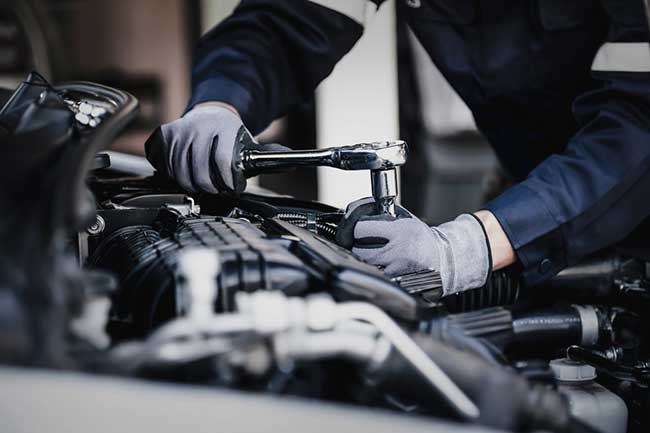Featured
Tire rotations are one of the most basic yet most efficient upkeep jobs to ensure your lorry runs efficiently and safely. This routine service rearranges tire wear, giving many benefits for your vehicle's efficiency, safety, and your budget.
What Does Tire Turning Involve?
Tire turning is the procedure of regularly changing the setting of each tire on your vehicle. As an example, front tires may be swapped with back ones, or tires might be moved diagonally. The specific pattern relies on variables like your automobile's drivetrain (front-wheel, rear-wheel, or all-wheel drive) and the kind of tires you have.
![]()
Why Tire Rotations Are Vital
Advertises Also Walk Wear. Different tires birth different amounts of weight and tension depending on their setting. Front tires often use faster because they take care of guiding and stopping. Regular rotations cancel the wear, guaranteeing all four tires have comparable walk depths.
Prolongs Tire Life Expectancy. Unequal wear causes premature tire substitutes. Revolving your tires can prolong their lifespan, saving you cash in time.
Improves Car Efficiency. Balanced tires improve stability, managing, and grip. Whether you're collaring, braking, or driving on slippery roadways, evenly used tires guarantee a smoother and safer driving experience.
![]()
Enhances Gas Effectiveness. Tires with uneven step wear can develop much more rolling resistance, that makes your engine work tougher and eats more gas. Normal turnings aid preserve ideal fuel effectiveness.
Makes Sure Security. Used tires can compromise braking range and control. By revolving your tires, you keep even minimize the risk and put on of blowouts or skidding.
Just How Commonly Should You Turn Your Tires?
Specialists suggest turning your tires every 5,000 to 7,500 miles. A convenient technique is to couple tire rotations with oil changes. Nevertheless, constantly consult your vehicle's owner guidebook for specific standards.
Common Rotation Patterns
Rotation patterns rely on your car's drivetrain and tire kind:
Front-Wheel Drive (FWD): Front tires move to the back, and back tires go across to the front.
Rear-Wheel Drive (RWD): Back tires transfer to the front, and front tires cross to the back.
Four-wheel Drive (AWD): Tires adhere to an "X" pattern to make sure balanced wear.
Directional Tires: These tires must remain on the very same side of the vehicle and are swapped front to back.
Signs Your Tires Required Rotation
Uneven walk wear.
![]()
Reduced gas efficiency.
Vibrations while driving, specifically at broadband.
Problem dealing with the vehicle in negative weather.
Last Thoughts
Tire turnings are a very easy way to safeguard your financial investment and boost your driving experience. By rearranging wear, you can extend the life of your tires, improve gas efficiency, and guarantee your security on the roadway. Arrange routine tire turnings with a relied on mechanic and make it a constant component of your automobile's upkeep routine.
What Does Tire Turning Involve?
Tire turning is the procedure of regularly changing the setting of each tire on your vehicle. As an example, front tires may be swapped with back ones, or tires might be moved diagonally. The specific pattern relies on variables like your automobile's drivetrain (front-wheel, rear-wheel, or all-wheel drive) and the kind of tires you have.

Why Tire Rotations Are Vital
Advertises Also Walk Wear. Different tires birth different amounts of weight and tension depending on their setting. Front tires often use faster because they take care of guiding and stopping. Regular rotations cancel the wear, guaranteeing all four tires have comparable walk depths.
Prolongs Tire Life Expectancy. Unequal wear causes premature tire substitutes. Revolving your tires can prolong their lifespan, saving you cash in time.
Improves Car Efficiency. Balanced tires improve stability, managing, and grip. Whether you're collaring, braking, or driving on slippery roadways, evenly used tires guarantee a smoother and safer driving experience.

Enhances Gas Effectiveness. Tires with uneven step wear can develop much more rolling resistance, that makes your engine work tougher and eats more gas. Normal turnings aid preserve ideal fuel effectiveness.
Makes Sure Security. Used tires can compromise braking range and control. By revolving your tires, you keep even minimize the risk and put on of blowouts or skidding.
Just How Commonly Should You Turn Your Tires?
Specialists suggest turning your tires every 5,000 to 7,500 miles. A convenient technique is to couple tire rotations with oil changes. Nevertheless, constantly consult your vehicle's owner guidebook for specific standards.
Common Rotation Patterns
Rotation patterns rely on your car's drivetrain and tire kind:
Front-Wheel Drive (FWD): Front tires move to the back, and back tires go across to the front.
Rear-Wheel Drive (RWD): Back tires transfer to the front, and front tires cross to the back.
Four-wheel Drive (AWD): Tires adhere to an "X" pattern to make sure balanced wear.
Directional Tires: These tires must remain on the very same side of the vehicle and are swapped front to back.
Signs Your Tires Required Rotation
Uneven walk wear.

Reduced gas efficiency.
Vibrations while driving, specifically at broadband.
Problem dealing with the vehicle in negative weather.
Last Thoughts
Tire turnings are a very easy way to safeguard your financial investment and boost your driving experience. By rearranging wear, you can extend the life of your tires, improve gas efficiency, and guarantee your security on the roadway. Arrange routine tire turnings with a relied on mechanic and make it a constant component of your automobile's upkeep routine.
Latest Posts
Recognizing Carpet Guarantees: What Homeowners Required to Know
Published Jan 07, 25
1 min read
Experience The Red Hawk Events: Live Music & Amazing Energy.
Published Jan 07, 25
1 min read
Artisanal Wooden Doors
Published Jan 07, 25
0 min read